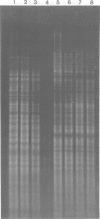Abstract
Intrafamilial cases of infection with the same strain of Helicobacter pylori (H pylori) have been reported but these clusters were too small to distinguish between person to person spread or coinfection from a common environmental source. To gain more information on the mode of transmission of H pylori, an epidemiological survey with bacterial strain differentiation by restriction endonuclease analysis of chromosomal DNA was carried out in an institution of 117 children with encephalopathy (aged 3.5 to 19 years). All children with antibodies against H pylori had gastroscopy to obtain gastric biopsy specimens. The prevalence of infection (confirmed histologically or microbiologically, or both) was 38% (45/117), and rose to 67% in one of the five sections of the institution. H pylori was isolated in 34/45 cases, and 22 different strains were found of which five strains were present in more than one child. Up to seven children were infected by the same strain, five of them were living in the same section. Analysis of the characteristics of infected children showed the predominant role of living conditions and the period of time cohabiting in this unexpectedly high prevalence of H pylori infection in children living in good sanitary conditions.
Full text
PDF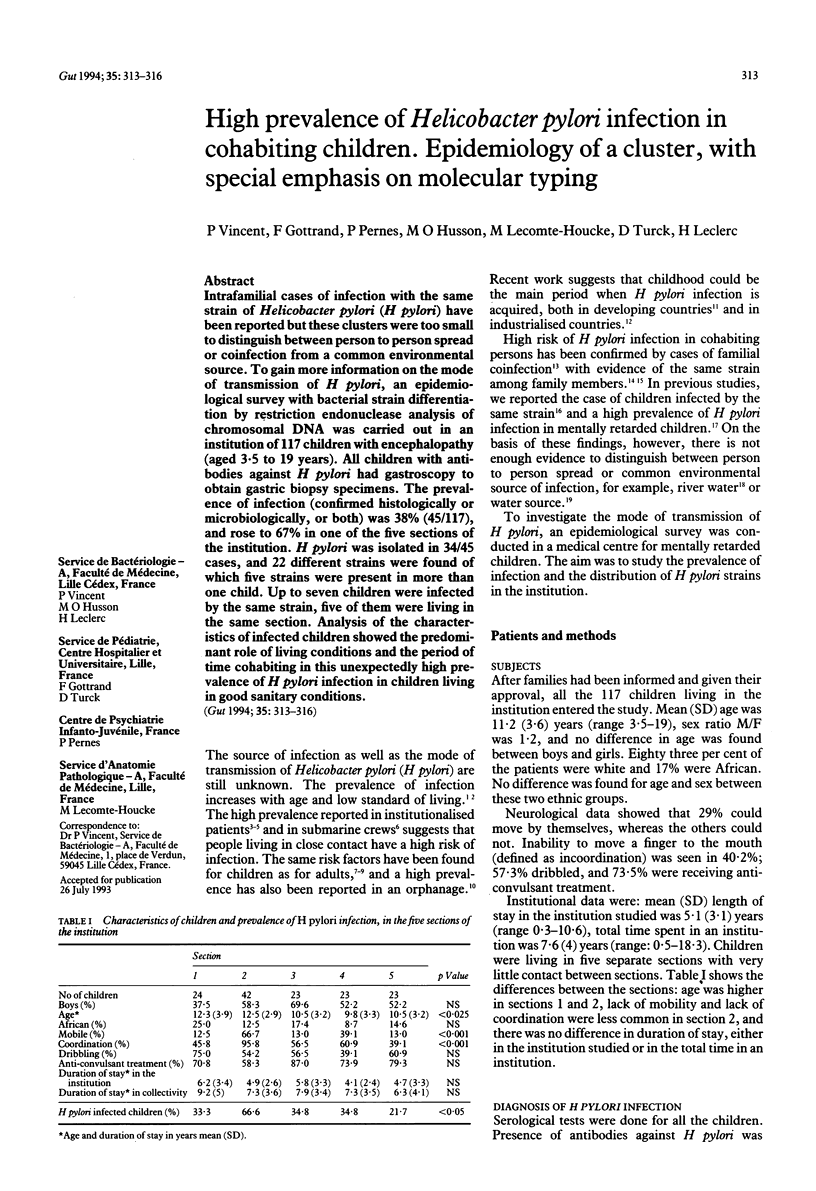
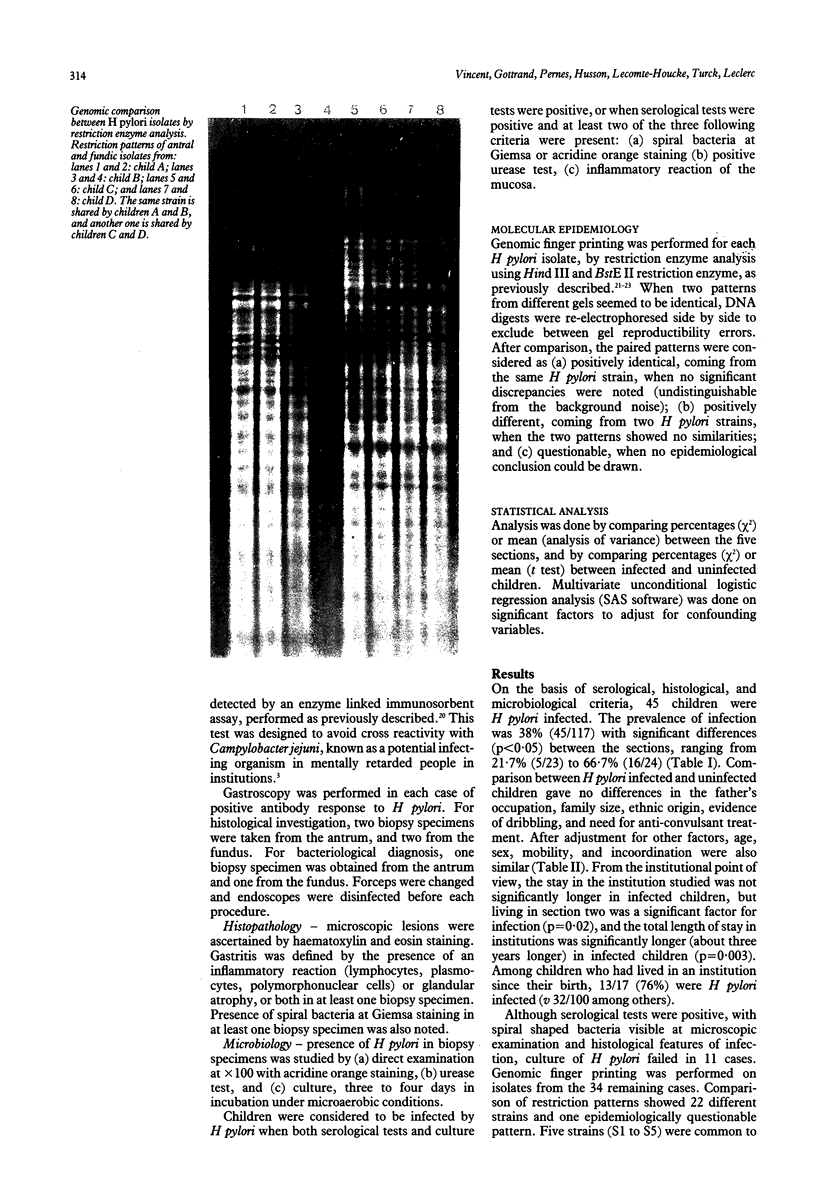
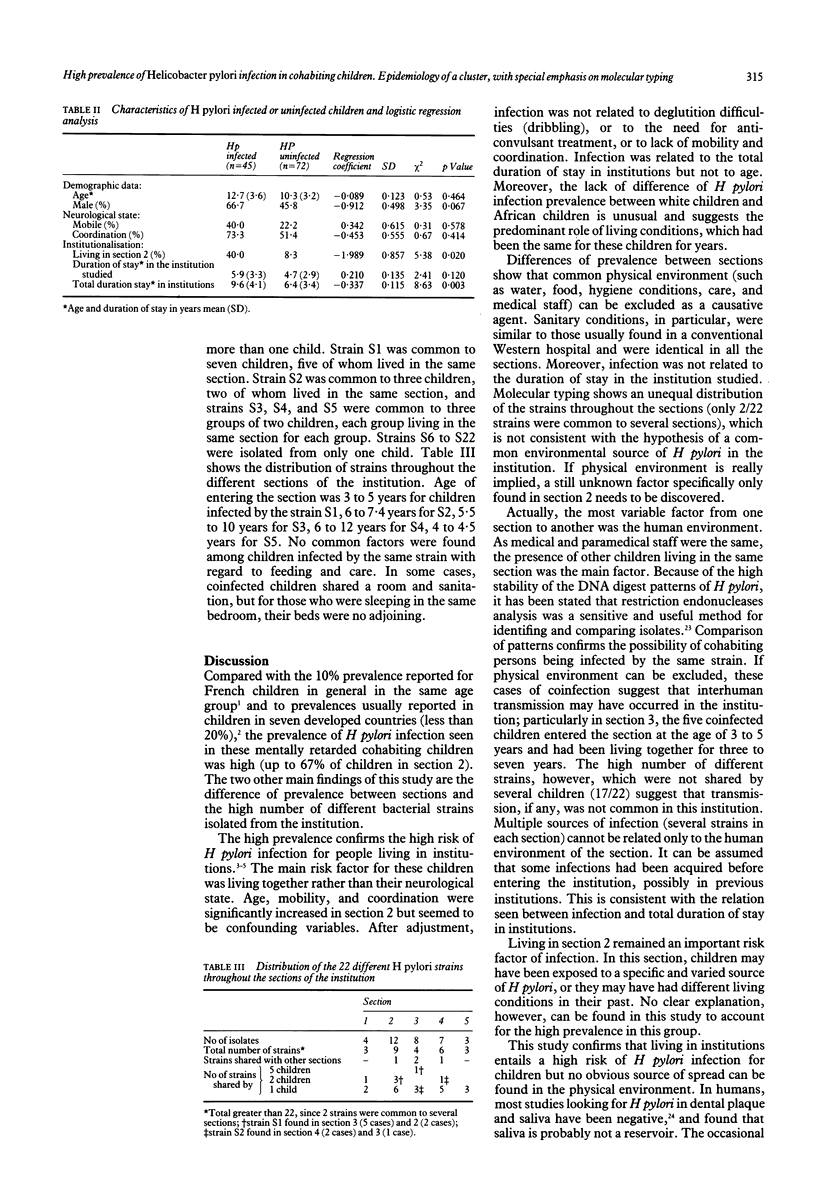
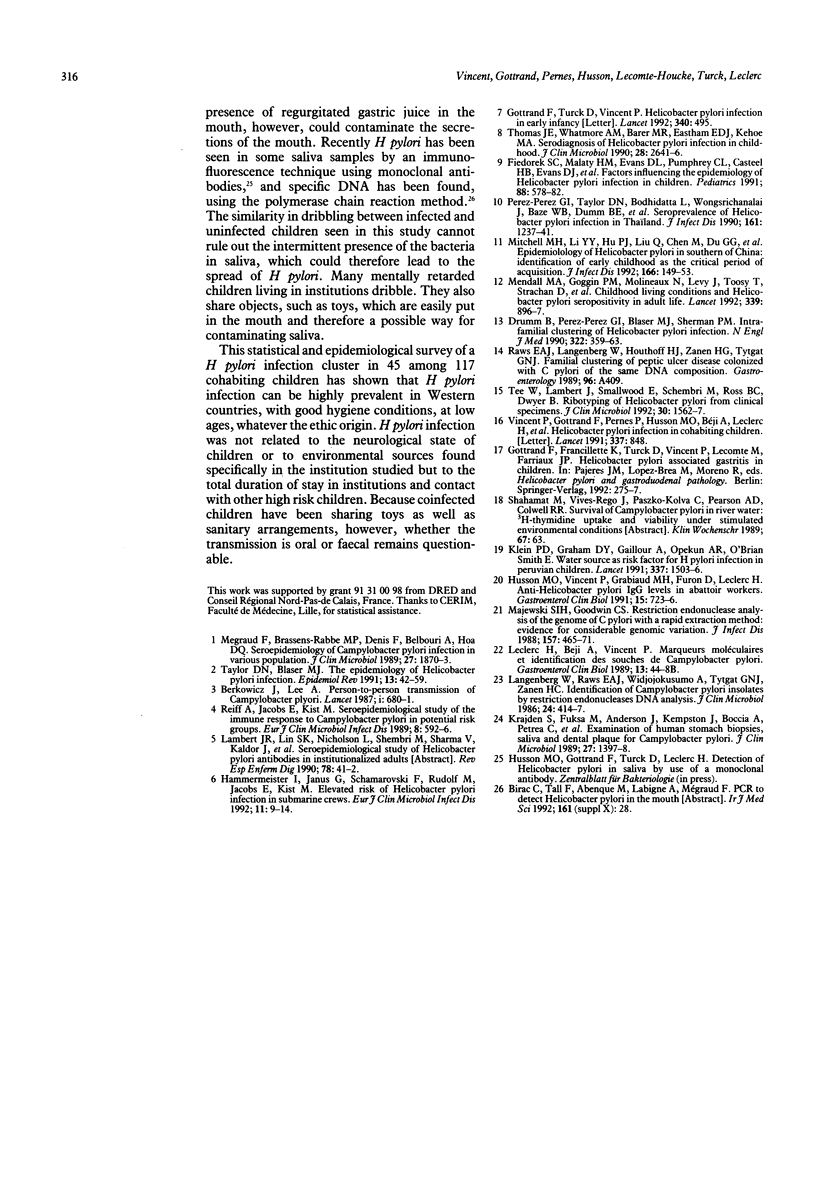
Images in this article
Selected References
These references are in PubMed. This may not be the complete list of references from this article.
- Berkowicz J., Lee A. Person-to-person transmission of Campylobacter pylori. Lancet. 1987 Sep 19;2(8560):680–681. doi: 10.1016/s0140-6736(87)92458-5. [DOI] [PubMed] [Google Scholar]
- Drumm B., Perez-Perez G. I., Blaser M. J., Sherman P. M. Intrafamilial clustering of Helicobacter pylori infection. N Engl J Med. 1990 Feb 8;322(6):359–363. doi: 10.1056/NEJM199002083220603. [DOI] [PubMed] [Google Scholar]
- Fiedorek S. C., Malaty H. M., Evans D. L., Pumphrey C. L., Casteel H. B., Evans D. J., Jr, Graham D. Y. Factors influencing the epidemiology of Helicobacter pylori infection in children. Pediatrics. 1991 Sep;88(3):578–582. [PubMed] [Google Scholar]
- Gottrand F., Turck D., Vincent P. Helicobacter pylori infection in early infancy. Lancet. 1992 Aug 22;340(8817):495–495. doi: 10.1016/0140-6736(92)91824-r. [DOI] [PubMed] [Google Scholar]
- Hammermeister I., Janus G., Schamarowski F., Rudolf M., Jacobs E., Kist M. Elevated risk of Helicobacter pylori infection in submarine crews. Eur J Clin Microbiol Infect Dis. 1992 Jan;11(1):9–14. doi: 10.1007/BF01971264. [DOI] [PubMed] [Google Scholar]
- Herrera Fernández F. A., Sarmiento Robles C., Blasco Carratalá F., Muñoz Espejo J., Plaza Moreno F. Colecistitis aguda alitiásica amebiana. Rev Esp Enferm Dig. 1990 Jul;78(1):41–42. [PubMed] [Google Scholar]
- Husson M. O., Vincent P., Grabiaud M. H., Furon D., Leclerc H. Anti-Helicobacter pylori IgG levels in abattoir workers. Gastroenterol Clin Biol. 1991;15(10):723–726. [PubMed] [Google Scholar]
- Klein P. D., Graham D. Y., Gaillour A., Opekun A. R., Smith E. O. Water source as risk factor for Helicobacter pylori infection in Peruvian children. Gastrointestinal Physiology Working Group. Lancet. 1991 Jun 22;337(8756):1503–1506. doi: 10.1016/0140-6736(91)93196-g. [DOI] [PubMed] [Google Scholar]
- Krajden S., Fuksa M., Anderson J., Kempston J., Boccia A., Petrea C., Babida C., Karmali M., Penner J. L. Examination of human stomach biopsies, saliva, and dental plaque for Campylobacter pylori. J Clin Microbiol. 1989 Jun;27(6):1397–1398. doi: 10.1128/jcm.27.6.1397-1398.1989. [DOI] [PMC free article] [PubMed] [Google Scholar]
- Langenberg W., Rauws E. A., Widjojokusumo A., Tytgat G. N., Zanen H. C. Identification of Campylobacter pyloridis isolates by restriction endonuclease DNA analysis. J Clin Microbiol. 1986 Sep;24(3):414–417. doi: 10.1128/jcm.24.3.414-417.1986. [DOI] [PMC free article] [PubMed] [Google Scholar]
- Majewski S. I., Goodwin C. S. Restriction endonuclease analysis of the genome of Campylobacter pylori with a rapid extraction method: evidence for considerable genomic variation. J Infect Dis. 1988 Mar;157(3):465–471. doi: 10.1093/infdis/157.3.465. [DOI] [PubMed] [Google Scholar]
- Mendall M. A., Goggin P. M., Molineaux N., Levy J., Toosy T., Strachan D., Northfield T. C. Childhood living conditions and Helicobacter pylori seropositivity in adult life. Lancet. 1992 Apr 11;339(8798):896–897. doi: 10.1016/0140-6736(92)90931-r. [DOI] [PubMed] [Google Scholar]
- Mitchell H. M., Li Y. Y., Hu P. J., Liu Q., Chen M., Du G. G., Wang Z. J., Lee A., Hazell S. L. Epidemiology of Helicobacter pylori in southern China: identification of early childhood as the critical period for acquisition. J Infect Dis. 1992 Jul;166(1):149–153. doi: 10.1093/infdis/166.1.149. [DOI] [PubMed] [Google Scholar]
- Mégraud F., Brassens-Rabbé M. P., Denis F., Belbouri A., Hoa D. Q. Seroepidemiology of Campylobacter pylori infection in various populations. J Clin Microbiol. 1989 Aug;27(8):1870–1873. doi: 10.1128/jcm.27.8.1870-1873.1989. [DOI] [PMC free article] [PubMed] [Google Scholar]
- Perez-Perez G. I., Taylor D. N., Bodhidatta L., Wongsrichanalai J., Baze W. B., Dunn B. E., Echeverria P. D., Blaser M. J. Seroprevalence of Helicobacter pylori infections in Thailand. J Infect Dis. 1990 Jun;161(6):1237–1241. doi: 10.1093/infdis/161.6.1237. [DOI] [PubMed] [Google Scholar]
- Reiff A., Jacobs E., Kist M. Seroepidemiological study of the immune response to Campylobacter pylori in potential risk groups. Eur J Clin Microbiol Infect Dis. 1989 Jul;8(7):592–596. doi: 10.1007/BF01968135. [DOI] [PubMed] [Google Scholar]
- Taylor D. N., Blaser M. J. The epidemiology of Helicobacter pylori infection. Epidemiol Rev. 1991;13:42–59. doi: 10.1093/oxfordjournals.epirev.a036078. [DOI] [PubMed] [Google Scholar]
- Tee W., Lambert J., Smallwood R., Schembri M., Ross B. C., Dwyer B. Ribotyping of Helicobacter pylori from clinical specimens. J Clin Microbiol. 1992 Jun;30(6):1562–1567. doi: 10.1128/jcm.30.6.1562-1567.1992. [DOI] [PMC free article] [PubMed] [Google Scholar]
- Thomas J. E., Whatmore A. M., Barer M. R., Eastham E. J., Kehoe M. A. Serodiagnosis of Helicobacter pylori infection in childhood. J Clin Microbiol. 1990 Dec;28(12):2641–2646. doi: 10.1128/jcm.28.12.2641-2646.1990. [DOI] [PMC free article] [PubMed] [Google Scholar]
- Vincent P., Gottrand F., Pernes P., Husson M. A., Beju A., Leclerc H., Farriaux J. P. Helicobacter pylori infection in cohabiting children. Lancet. 1991 Apr 6;337(8745):848–848. doi: 10.1016/0140-6736(91)92550-l. [DOI] [PubMed] [Google Scholar]



